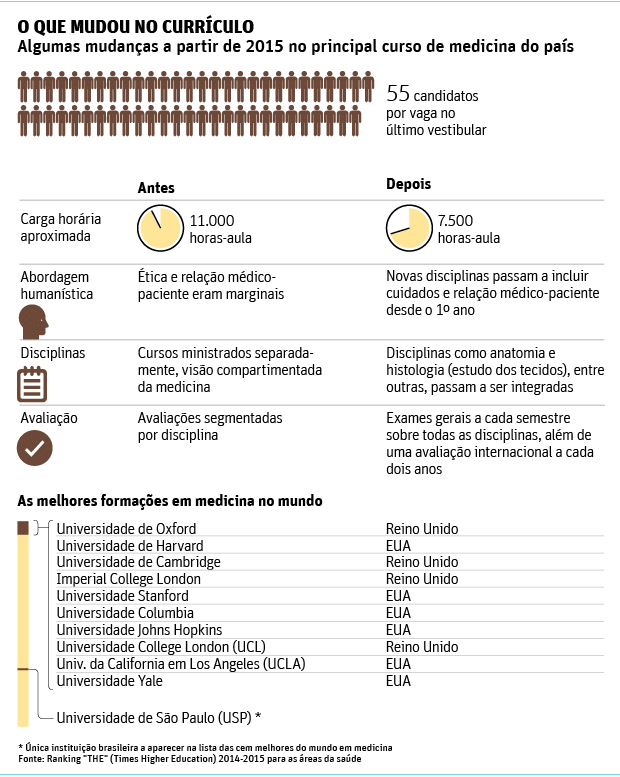Buscando humanização, Medicina da USP reduz tempo em sala de aula
Quem começou medicina na USP neste ano encontrou cenário de mudança. A
graduação de seis anos, considerada a melhor do país, sofreu redução de
30% no número de disciplinas, que agora são oferecidas de forma mais
integrada. O curso ganhou abordagem mais humanizada, com foco no
paciente.
Os novos alunos estudam conjuntamente temas que antes ficavam em gavetas
separadas, caso de anatomia e histologia (estudo dos tecidos). As
provas se tornaram semestrais, avaliando o conteúdo de maneira mais
unificada.
Paralelamente, outros temas ganharam espaço no currículo, como "ciclos
da vida", disciplina que aparece no primeiro ano do curso e dá noções de
cuidados médicos na infância e terceira idade.
Lalo de Almeida/Folhapress

Médico
veste jaleco com o logo da medicina da USP no Instituto de Ortopedia e
Traumatologia do Hospital das Clínicas em São Paulo.
O aluno passa menos tempo na sala de aula: se antes ficava quase oito
horas por dia confinado, agora a taxa gira em torno de cinco horas.
"Com o tempo que sobra, o estudante pode se envolver em pesquisa e em
trabalhos de extensão voltados ao atendimento de pacientes", diz Edmund
Chada Baracat, ginecologista e docente da USP que encabeçou a mudança.
Esse tipo de currículo, mais moderno e flexível, já é seguido por
escolas top do mundo há muito tempo. Nos EUA, país que concentra seis
das dez melhores universidades de medicina do mundo, segundo o ranking
Times Higher Education, um estudante não passa mais que três horas em
aulas expositivas.
"Às vezes, um professor dá exercício em aula de manhã e os alunos têm de
resolvê-lo sozinhos ou em grupos até o fim do dia", conta Ana Flávia
Garcia Silva, 22. Estudante do quinto ano da USP, ela traz no currículo
intercâmbios em Harvard e Michigan.
Quando esteve na primeira universidade -considerada a segunda melhor do
mundo-, passou quase o tempo todo no laboratório. Ao voltar para o
Brasil, teve de "repetir" um ano no curso porque não conseguiu
equivalência do que estudou lá com disciplinas obrigatórias daqui.
"Quando vi as mudanças no curso da USP, queria prestar vestibular de
novo", brinca.
| Editoria de Arte/Folhapress | ||
 |
BEBENDO NA FONTE
Parte das inspirações para a mudança da USP veio justamente dos EUA.
Apesar de diferenças cruciais na formação educacional nos dois países,
há aspectos que ainda podem ser importados.
"Aqui, a relação médico-paciente passa por disciplinas, exercícios e
estudos de caso", diz Marcos Montagnini, geriatra e responsável pelo
grupo de cuidados paliativos da Universidade de Michigan, uma das
instituições que influenciaram a USP.
São os profissionais de paliativos que trabalham a humanização da
medicina de maneira mais profunda, tratando aspectos físicos,
psicológicos e espirituais de pacientes com doenças crônicas terminais.
Nos EUA, a disciplina é obrigatória há mais de uma década.
Por aqui, não há essa exigência. Para Baracat, da USP, a redução da
carga horária pode fazer com que os estudantes tenham tempo para se
dedicar a assuntos mais humanistas, como paliativos, ainda na graduação.
"Antes isso era quase impossível."
Giovanni Guido Cerri, diretor da AMB (Associação Médica Brasileira),
avalia que a mudança no curso da principal universidade do país é
simbólica. Dá um oportuno chacoalhão no tom em que o médico vinha sendo
formado. "Mas ainda falta o estudante conhecer com mais profundidade o
SUS e as características da nossa saúde pública e privada", diz. "O
Brasil é complexo, e precisamos formar os médicos adequados para um país assim."



